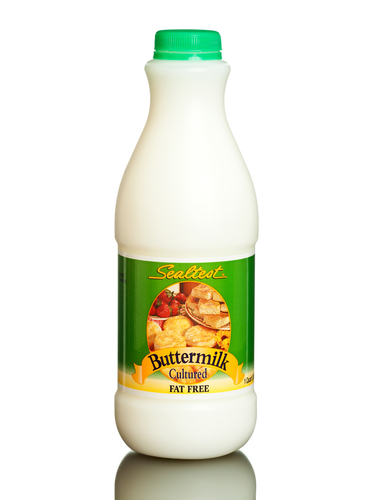Is Buttermilk Bad For You?
Also Known As: traditional buttermilk, cultured buttermilk
Short answer
Buttermilk is great for baking or even drinking on its own. It contains many essential nutrients. When purchasing buttermilk, it is best to purchase fat-free or reduced-fat buttermilk rather than the full-fat variety.
Recommended Alternative
Overall beneficial to your health. Things rated a 'B' may have some harmful qualities to pay attention to.
View Full Grading System
Category 'A'
Very healthy and numerous health benefits. Side effects are rare. Things rated an 'A+' are typically necessary for survival (for example, water).
Very healthy and numerous health benefits. A few harmful qualities may be associated, but only under certain circumstances such as an allergic reaction.
Very healthy and numerous health benefits. Harmful qualities may be associated, but aren't usually serious.
It is important to note that even the best things in life can become bad in immoderate amounts. So, although something may be rated an 'A+', overconsumption/overdoing can bring unwanted effects.
Category 'B'
Very beneficial to your health. Things rated a 'B+' may have a few harmful qualities to pay attention to.
Overall beneficial to your health. Things rated a 'B' may have some harmful qualities to pay attention to.
More beneficial to your health than not. However, harmful qualities are most likely associated and shouldn't be overlooked.
The main difference between category 'A' and category 'B' is the harmful qualities typically present in 'B' items. Serious side effects are usually uncommon, but are still possible and should be taken note of.
Category 'C'
Both beneficial and harmful qualities associated. Things rated a 'C+' are typically a bit more on the beneficial side. Still, moderation is important.
A fairly even ratio of beneficial and harmful qualities. Moderation is important. Very general topics that can lean towards both sides of the spectrum will be placed here as well. Rice, for example, can be good or bad depending on the type.
More harmful than beneficial. Side effects are common, especially when consumed/done excessively. Moderation is very important.
Category 'C' usually denotes to both good and bad qualities. When it comes to this category, it is important to keep this word in mind: moderation.
Category 'D'
Harmful to your health. Although benefits may be associated, the bad most likely outweighs the good. Moderation is very important.
Harmful to your health. A few benefits may be associated, but the bad outweighs the good. Moderation is extremely important.
Harmful to your health. Very few, if any, benefits are present. Things in this category should be avoided as much as possible.
Category 'D' is typically for things that are more harmful than beneficial. While consuming/doing something unhealthy once in a blue moon shouldn't hurt, we definitely recommend eliminating 'D' items as a regular part of your routine/diet.
Category 'F'
Category 'F' is for things that fail to bring anything beneficial to the table, and are very harmful to your health. We recommend completely avoiding anything in this category. Long-term side effects of 'F' items are usually very serious.
Category 'N'
'N' stands for neutral. Things placed into this category are generally (a) neither good nor bad for you, or (b) lack the necessary evidence to reach any conclusions.
Long answer
The traditional type of homemade buttermilk comes with a taste than many will describe as sour or tart, and is the residual liquid that is left over once butter has been churned. Buttermilk is what is referred to as probiotic food that is known to contains living microorganisms which are beneficial to our health. These microorganisms are known to be so powerful that they are capable of surviving through our digestive passages, directly from our mouth to our stomach and become active once they reach our intestines.
Many years ago, buttermilk was obtained as a product for consumption that was left over after skimming butter from milk production. The remaining liquid that was gathered from the milk was then allowed to ferment naturally which soon produced a thin and sweet traditional variation of buttermilk. These days, buttermilk is produced by adding healthy and beneficial living bacteria into low-fat or full-fat milk. This ‘good’ bacteria which is added to milk help to increase many health benefits. Some of the benefits include improved digestion, a boosted immune system, protein intake, and the building of stronger bones. It has also been proven to combat acidity, vitamin deficiency, and even cancer.
Possible short-term side effects
- increased buildup of phlegm
Possible long-term side effects
- weight gain
-
increased blood pressure
-
increased cholesterol
Ingredients to be aware of
Benefits
- aids in digestion
-
prevents vitamin deficiency
-
combats acidity
-
boosts immune system
-
reduced risk of cancer
-
builds strong bones
-
great protein source
Healthier alternatives
Our Wellness Pick
(what is this?)
Califia Unsweetened Almond Milk
- Dairy-free alternative
- Supports keto lifestyle
- Non-GMO
- Sugar-free
- High in calcium
Learn More!
Please turn your Ad Blocker off to see this content. Thank you!
Thank you for your feedback!
Written by Rachel Adams
Published on: 12-28-2015
Last updated: 12-15-2023
Thank you for your feedback!
Written by Rachel Adams
Published on: 12-28-2015
Last updated: 12-15-2023

 Approved by
Approved by 















